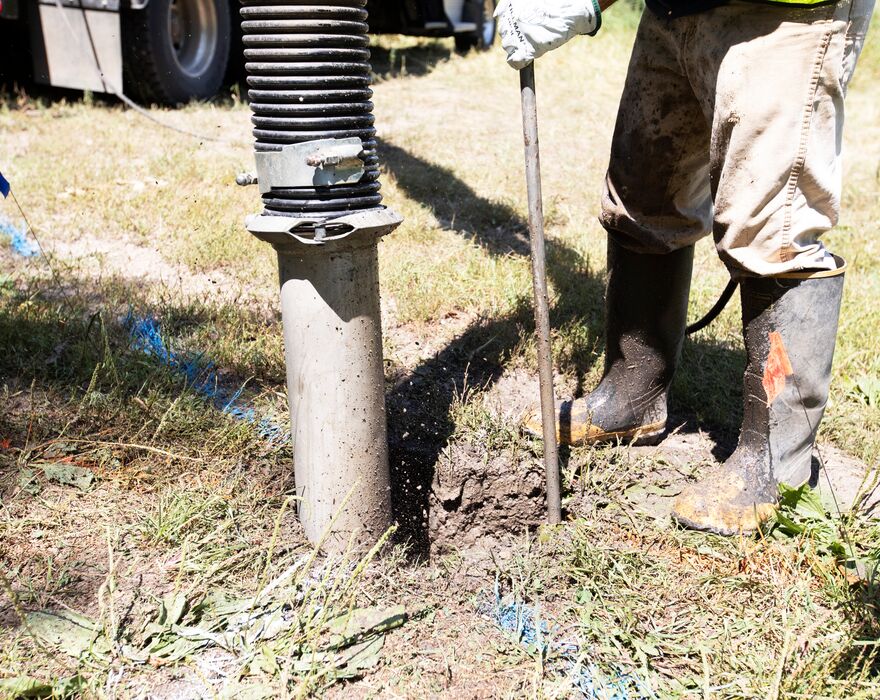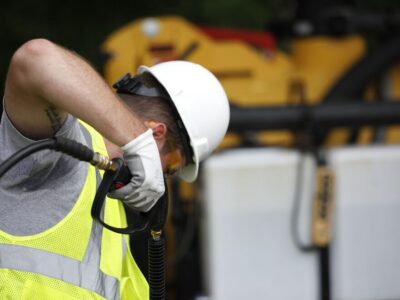“Always wear a hard hat, safety shoes, hearing protection and wraparound eye protection or goggles. Other workers in the immediate area must also wear hard hats, safety shoes, hearing protection and eye protection. A face shield is advised when excavating near loose materials.”
Vacuum excavation uses pressurized air or water to break up materials before removing them with the vacuum. This soft dig process helps protect existing infrastructure while crews efficiently locate buried utilities. Though vacuum excavators are known to help minimize the chance of a utility strike, crew members using this equipment must use the proper personal protective equipment (PPE). Refer to your machine’s operator’s manual for more information on required PPE.
Always wear a hard hat, safety shoes, hearing protection and wraparound eye protection or goggles. Other workers in the immediate area must also wear hard hats, safety shoes, hearing protection and eye protection. A face shield is advised when excavating near loose materials. It must meet ANSI Standard Z87.1 – 2010 and be marked “Z87+.”
Electric utilities mandate additional PPE
When vacuum excavating at a site where electric utilities are present, the operator and anyone standing on the ground during vacuum excavation near energized power lines must wear electrically insulated gloves and boots.
Rubber electrically insulated gloves, when in good condition and correctly used, help protect against electrical burns. There are standards that need to be followed. Gloves must be at least Class 2, with a voltage rating of 17,000 V or more. You also need to wear leather protectors over gloves. These protect the gloves but do not protect against electrical shocks or burns.
Maintain insulated gloves
Correct care of gloves is an essential part of PPE. This requires diligent inspection and adherence to best practice. You should:
- Visually inspect gloves and leather protectors before each use. Check for signs of physical damage or chemical deterioration such as swelling, softness, hardening, stickiness, ozone deterioration or sun-checking from prolonged exposure to sunlight. If damaged at all, do not use them.
- Check leather protectors for metal particles, embedded wire, abrasive materials or substances that could cause puncture, abrasion, contamination or deterioration. Adequate flashover distance of 2 in (5 cm) between the top of the protector and the bead of the rubber glove should be maintained. The minimum uncovered distance must be 1 in (2.5 cm) above the protector cuff top for each 10,000 V.
- Do not fold gloves. Folding may cause cracks. Store gloves in a bag when not in use.
- Keep gloves clean. The gloves will be more comfortable to wear, and damage will be more visible.
- Prevent snags. Do not wear rings, watches, jewelry or other sharp objects on hands or arms. Check whether red or yellow inner layers show through the black outer layer, indicating the gloves have been cut or snagged.
- Prevent contact with wood or metal splinters or other sharp objects which may damage gloves.
- Prevent contact with chemicals, which can damage gloves. If contact is made with chemicals, wipe gloves off immediately. Clean gloves with a mild soap, then rinse with clear water and let them dry.
- The ASTM In-Service specifications call for an electrical retest of gloves at a test lab every six months. This test is to recertify the non-conductivity of the gloves. Contact your Vermeer dealer for the location of the test lab in your area or a listing of the test labs.
- Check inside each glove and air test for pinholes.
Inspect insulated boots
Rubber electrically insulated boots, when in good condition, also help protect from electrical burns. Boots must meet or exceed electrical hazard protection requirements when tested at 14,000 V.
Before each use, check that the boots are in proper condition:
- Check for cracks, holes and unusual wear on the sole. If there is damage, discard the boots.
- After each use, rinse boots with water to remove mud, chemicals and debris.
- The boots are made with natural rubber, so it is important to use a rubber protectant or coat them with furniture polish. This keeps rubber soft and helps prevent pinholes, stress cracks, dry rot and ozone deterioration.

Vermeer MV Solutions offers the vacuum excavation technology, equipment, training and support to the growing underground utility and soft dig markets. Contact your Vermeer dealer to learn more.
Vermeer MV Solutions, Inc. reserves the right to make changes in product engineering, design and specifications; add improvements; or discontinue manufacturing or distribution at any time without notice or obligation. Equipment shown is for illustrative purposes only and may display optional accessories or components specific to their global region. Please contact your local Vermeer dealer for more information on machine specifications.
Vermeer and the Vermeer logo are trademarks of Vermeer Manufacturing Company in the U.S. and/or other countries. © 2023 Vermeer MV Solutions, Inc. All Rights Reserved.
